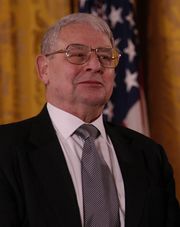Riccardo Giacconi
| Riccardo Giacconi | |
|---|---|
 National Medal of Science award ceremony, 2003
|
|
| Born | October 6, 1931 Genoa, Italy |
| Residence | United States |
| Nationality | Italy United States |
| Fields | Physics |
| Institutions | Johns Hopkins University Chandra X-ray Observatory |
| Alma mater | University of Milan |
| Doctoral advisor | |
| Doctoral students | |
| Known for | Astrophysics |
| Notable awards | Nobel Prize in Physics (2002) Elliott Cresson Medal (1980) |
Riccardo Giacconi (born October 6, 1931) is an Italian/American Nobel Prize-winning astrophysicist who laid the foundations of X-ray astronomy.
Biography
Born in Genoa, Italy, he received a degree from the University of Milan before moving to the US to pursue a career in astrophysics research. He became an American citizen.[1]
Cosmic X-ray radiation is absorbed by the Earth's atmosphere, and so space-based telescopes are needed for X-ray astronomy. Giacconi worked on the instrumentation for X-ray astronomy, from rocket-borne detectors in the late 1950s and early 1960s, through to Uhuru, the first orbiting X-ray astronomy satellite, the Einstein Observatory, the first fully imaging X-ray telescope put into space, and the Chandra X-ray Observatory which was launched in 1999 and is still in operation. Giacconi also transferred his expertise to other fields of astronomy, including being the first director of the Space Telescope Science Institute, the science operations center for the Hubble Space Telescope.
Giacconi was awarded a share of the Nobel Prize in Physics in 2002 "for pioneering contributions to astrophysics, which have led to the discovery of cosmic X-ray sources".[2] The other shares of the Prize in that year were awarded to Masatoshi Koshiba and Raymond Davis, Jr.. He has simultaneously held the position of professor of physics and astronomy (1982–1997) and research professor (since 1998) at Johns Hopkins University, and is now University Professor. During this time, he was also Director General of the European Southern Observatory (ESO) (1993–1999). He is currently principal investigator for the Chandra Deep Field-South project with NASA's Chandra X-ray Observatory.
Honour and awards
- Helen B. Warner Prize for Astronomy (1966)
- Bruce Medal (1981)[3]
- Henry Norris Russell Lectureship (1981)
- Heineman Prize (1981)
- Gold Medal of the Royal Astronomical Society (1982)
- Nobel Prize in Physics (2002)
- National Medal of Science (2003)
- Asteroid 3371 Giacconi
References
|
|||||||||||||||||||||||
|
||||||||||||||||||||
|
|||||||||||||||||